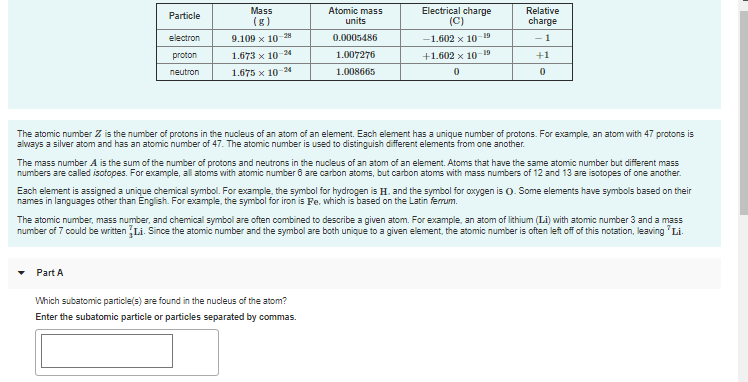Chemistry & Chemical Reactivity
9th Edition
ISBN:9781133949640
Author:John C. Kotz, Paul M. Treichel, John Townsend, David Treichel
Publisher:John C. Kotz, Paul M. Treichel, John Townsend, David Treichel
Chapter2: Atoms Molecules And Ions
Section: Chapter Questions
Problem 154GQ: Mass spectrometric analysis showed that there are four isotopes of an unknown element having the...
Related questions
Concept explainers
Atomic Structure
The basic structure of an atom is defined as the component-level of atomic structure of an atom. Precisely speaking an atom consists of three major subatomic particles which are protons, neutrons, and electrons. Many theories have been stated for explaining the structure of an atom.
Shape of the D Orbital
Shapes of orbitals are an approximate representation of boundaries in space for finding electrons occupied in that respective orbital. D orbitals are known to have a clover leaf shape or dumbbell inside where electrons can be found.
Question

Transcribed Image Text:Atomic mass
units
Electrical charge
(C)
Mass
Relative
Particle
(g)
charge
electron
9.109 x 10 28
0.0005486
-1.602 x 1019
- 1
proton
1.673 x 10-24
1.007276
+1.602 x 10- 19
+1
neutron
1.675 x 10-24
1.008665
The atomic number Z is the number of protons in the nucleus of an atom of an element. Each element has a unique number of protons. For example, an atom with 47 protons is
always a silver atom and has an atomic number of 47. The atomic number is used to distinguish different elements from one another.
The mass number A is the sum of the number of protons and neutrons in the nucleus of an atom of an element. Atoms that have the same atomic number but different mass
numbers are called isofopes. For example, all atoms with atomic number 8 are carbon atoms, but carbon atoms with mass numbers of 12 and 13 are isotopes of one another.
Each element is assigned a unique chemical symbol. For example, the symbol for hydrogen is H. and the symbol for oxygen is 0. Some elements have symbols based on their
names in languages other than English. For example, the symbol for iron is Fe. which is based on the Latin ferrum.
The atomic number, mass number, and chemical symbol are often combined to describe a given atom. For example, an atom of lithium (Li) with atomic number 3 and a mass
number of 7 could be written Li. Since the atomic number and the symbol are both unique t
given element, the atomic number is often left off of this notation,
'Li.
Part A
Which subatomic particle(s) are found in the nucleus of the atom?
Enter the subatomic particle or particles separated by commas.
Expert Solution
This question has been solved!
Explore an expertly crafted, step-by-step solution for a thorough understanding of key concepts.
This is a popular solution!
Trending now
This is a popular solution!
Step by step
Solved in 2 steps

Knowledge Booster
Learn more about
Need a deep-dive on the concept behind this application? Look no further. Learn more about this topic, chemistry and related others by exploring similar questions and additional content below.Recommended textbooks for you

Chemistry & Chemical Reactivity
Chemistry
ISBN:
9781133949640
Author:
John C. Kotz, Paul M. Treichel, John Townsend, David Treichel
Publisher:
Cengage Learning

Chemistry & Chemical Reactivity
Chemistry
ISBN:
9781337399074
Author:
John C. Kotz, Paul M. Treichel, John Townsend, David Treichel
Publisher:
Cengage Learning

Chemistry for Engineering Students
Chemistry
ISBN:
9781337398909
Author:
Lawrence S. Brown, Tom Holme
Publisher:
Cengage Learning

Chemistry & Chemical Reactivity
Chemistry
ISBN:
9781133949640
Author:
John C. Kotz, Paul M. Treichel, John Townsend, David Treichel
Publisher:
Cengage Learning

Chemistry & Chemical Reactivity
Chemistry
ISBN:
9781337399074
Author:
John C. Kotz, Paul M. Treichel, John Townsend, David Treichel
Publisher:
Cengage Learning

Chemistry for Engineering Students
Chemistry
ISBN:
9781337398909
Author:
Lawrence S. Brown, Tom Holme
Publisher:
Cengage Learning

Chemistry: An Atoms First Approach
Chemistry
ISBN:
9781305079243
Author:
Steven S. Zumdahl, Susan A. Zumdahl
Publisher:
Cengage Learning

Introductory Chemistry: A Foundation
Chemistry
ISBN:
9781337399425
Author:
Steven S. Zumdahl, Donald J. DeCoste
Publisher:
Cengage Learning

Introduction to General, Organic and Biochemistry
Chemistry
ISBN:
9781285869759
Author:
Frederick A. Bettelheim, William H. Brown, Mary K. Campbell, Shawn O. Farrell, Omar Torres
Publisher:
Cengage Learning